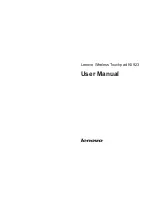
Page: 18
SmartPad LCD
© 2003 Xantech Corporation
Expansion:
This port is used to connect the SPLCD to an additional MRC88 Keypad. Connect using CAT5 cable
terminated at both ends with RJ45 connectors (using the EIA/TIA 568B standard) from the EXPANSION
connector (
Figure 3 – 14)
on the rear of the SPLCD Display into the RJ45 connector marked “Controller” on
the rear of the MRC88 keypad.
Note:
The Zone Termination Jumper (
Figure 3 – 16)
needs to be removed in this configuration and the
12V
Out to Expansion
jumper (
Figure 3 – 15)
needs to be installed.
S
ERIAL
RS422/232 P
ORT
W
IRING
:
(Figure 3 – 21)
This is a bi-directional RS422 port that can be run up to 4000ft. (1.2KM) to communicate with a remote
RS232 device. Use CAT5 cable terminated in RJ45 connectors. The RS422232 converter (sold separately)
and a 12VDC Power Supply are required located at the remote location within 30ft of the RS232 device to
be controlled.
Note:
Null Modem Adaptor may be necessary for proper communication. Please consult manufactures
specification of device being controlled.
DB9 Pin Out
Function
2
Rx
3
Tx
5
GND
RS422232 DB9 Pin Out
IR I
N
Z
ONE
:
(Figure 3 – 18)
To wire
local
emitters in-the-zone (emitters used to control components in the same general area as the
SmartPad LCD), wire the IR OUT and GND terminals on the rear of the SPLCD Display to the IR (white
stripe) and GND of the emitter cable. To control numerous components in the same area, wire these
terminals to an amplified connecting block (Xantech Model 791-44) using 18-20AWG 2-conductor cable. A
2-conductor screw-type removable connector is provided.
Note:
IR In Zone port is an MRC88 feature. This is active only when enabled in the MRC88 DragMRC
Software.
Xantech M
odel RS422232
RS422 to RS232 Convertor
CAT5 Wire
Up to 4000
(Terminate in RJ45)
Requires 12VDC Power Supply
(Xantech Model 781RG)
DB9 IO for local Control of RS232
Devices (i.e. Projector, Lighting
Control Systems, PC Control etc.)
CAT5 Wire To
MRC88 or MRC44 Control Input
(MRC88 Full Duplex Communication)
Figure 10 – Interfacing to MRC and Serial Control
















































